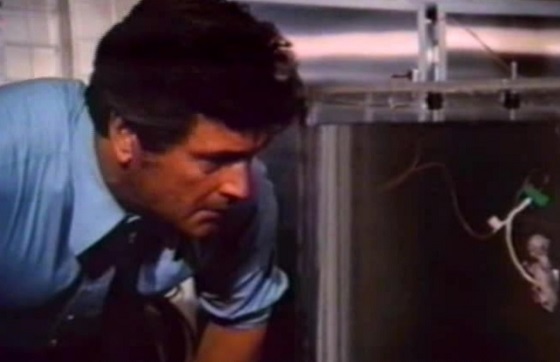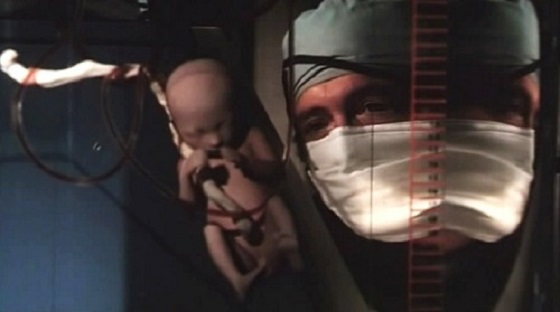Sometimes, science fiction horror movies are subtle, like the modern classics Ex Machina and 10 Cloverfield Lane. Other times, they’re pants-poopingly frightening, like Alien and Event Horizon. Still other times, however, they walk the line, becoming so crazy that the viewer is unsure as to what to think, like Phase IV and Prophecy. And then, there are movies like Embryo.

Embryo is about a researcher named Dr. Paul Holliston (Rock Hudson from Seconds) who accidentally hits a dog on a rainy night near his home. He brings the dog home, and while he is unable to save its life, he is able to extract an unborn fetus from the animal. Driven to the brink of madness by memories of the death of his wife, Dr. Holliston decides to inject growth hormones into the embryo in an effort to save it. His experiment works, and the dog is not only born healthy, but experiences rapid growth development. Unbeknownst to the doctor, the dog also exhibits advanced intelligence combined with homicidal urges.

Buoyed by his success, Dr. Holliston decides to try his experiment on a human. When a pregnant suicide victim dies in the emergency room, Dr. Holliston extracts her unborn child and puts it through the same process as the dog fetus, with similar results. The human embryo’s growth is a little more difficult to control, but once Dr. Holliston gets a handle on it, the fetus becomes a full grown woman that he names Victoria (Barbara Carrera from The Island of Dr. Moreau). But Victoria displays the same dangerous mental traits as the murderous dog.

Directed in 1976 by Ralph Nelson (Lilies of the Field, Once A Thief) from a screenplay by Jack W. Thomas (20,000 Eyes, 13 Fighting Men) and Anita Doohan (Whispers), Embryo begins with an ominous message from the movie’s technical advisor, one Charles R. Brinkman III M.D., that the film is ”not all science fiction” and that it is “based upon medical technology that currently exists,” finally warning the viewer that the events of the film “could be a possibility tomorrow…or today.” It is this type of hysteria and paranoia that Nelson utilizes in an attempt to make Embryo a horrifying cinematic experience. It’s not always effective, but it’s clear that the subliminal ideas behind Embryo are more frightening than the in-your-face theatrics of the movie itself.

For her part, the character of Victoria is a sympathetic antagonist. She’s evil, but has no idea why, and really has no control over it. Like many of the old Universal monsters, she did not ask to be brought into the world and did not seek to attain her special gifts. As innocent as she seems, however, she is a formidable foe. She’s not overly strong, but she possesses an intellect that allows her to absorb and process information far faster than any regular human being could learn it. In one scene, she bests a Chess grandmaster (played by the wonderful Roddy McDowall from Fright Night, Class of 1984, and the Planet of the Apes movies), despite having never played the game before and only having read about it in a book. She doesn’t quite have the mind of a child, but she’s not all fangs and claws either, even when she’s at her murderous worst.

The real star of Embryo is the dog – the subject of the first experiment, a Doberman whom Dr. Holliston nicknames “Number One.” He’s a cute dog, and shows the same high intellect that Victoria does later on in the film, but he hides his bloodthirsty deeds from his master. At one point, Dr. Holliston leaves the pup in his car, and Number One is able to open the door, kill another dog that is yapping at him, hide the body, get back in the car, and shut the door, all without the doctor even knowing he was gone. It’s actually a pretty impressive bit of animal training by Cindy James Cullen, who also trained the animals in Harry and the Hendersons and After Midnight, and it amounts to one of the most memorable scenes in the movie. Not to knock the rest of the film, but the dog scenes in Embryo are the most entertaining, walking the line between high suspense and the blackest of comedy. They’re the kind of scenes that make the viewer feel bad about the fact that they’re laughing at them.

Photographically, Embryo is fascinating to watch. It was shot by cinematographer Fred J. Koenkamp, who shot everything from Patton and Papillon to The Towering Inferno and The Amityville Horror. For what seems like such a throwaway movie, Koenkamp paid a lot of attention to its look, using plenty of interesting camera angles that peer at the subject through liquids and glass panels and such. The movie is filled with long shots and two shots, with camera motion following the subjects in just about every scene, giving the film a live, fly-on-the-wall type of vibe. And, of course, because Embryo deals with a lot of science, there’s no shortage of macro and microscopic shots, just to show the viewer that Dr. Holliston is working on some advanced stuff. Embryo may be a borderline science fiction horror movie, but Koenkamp makes it look really good.

In the sci-fi horror world, movies like Embryo are quickly forgotten. But that does not mean that they aren’t worth the time. Usually, they’re remarkably entertaining. And Embryo is.
